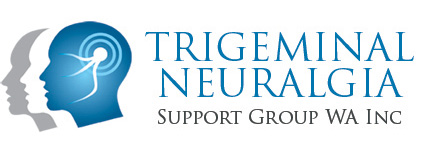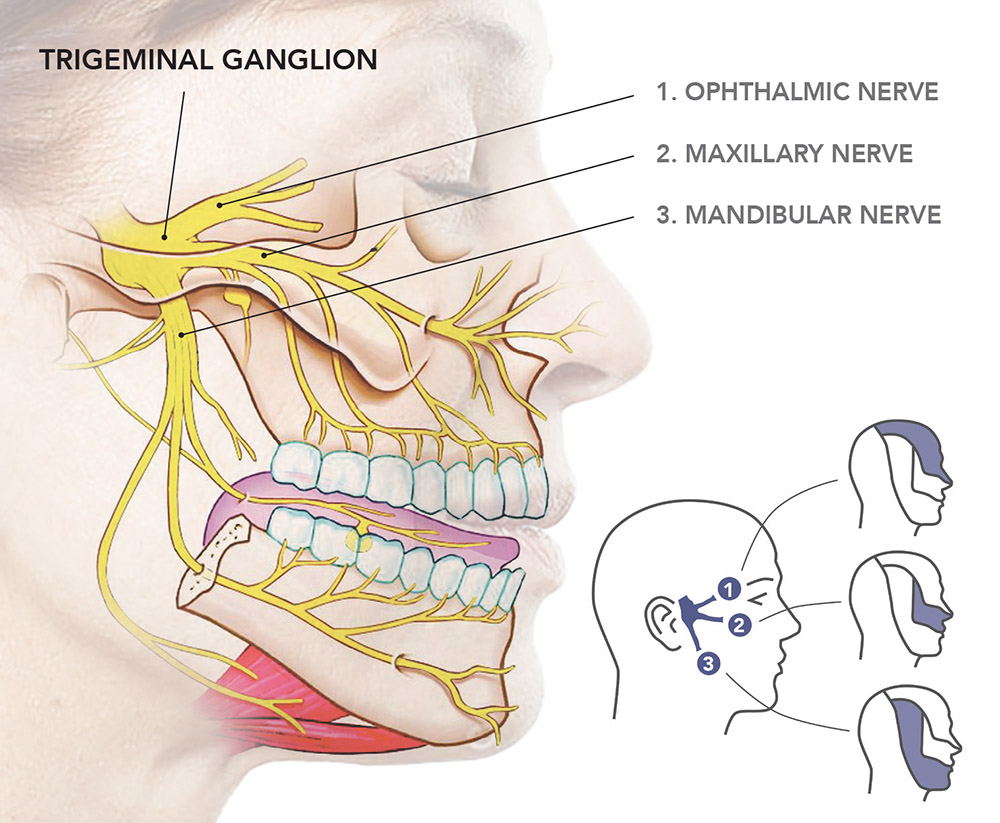More information on Medications
More information on Surgical Options
The Perth Support Group
Books and Documents
UNDERSTANDING TN
Trigeminal Neuralgia (TN) is a chronic disorder that usually affects people in middle or later life and only rarely in children or young adults. It is an excruciating facial pain that tends to come and go in sudden shock-like attacks and is due to a chronic disorder of the trigeminal nerve (5th cranial nerve) which is the largest of the body’s 12 pairs of cranial nerves.
The trigeminal nerve has three branches which conduct sensation from the upper, middle and lower portions of the face and also the oral cavity, to the brain. The painful attacks of TN can involve one or more branches. Most commonly the middle branch or lower branch either individually or in combination with each other are involved. Only about 4% of patients experience pain in the upper branch. In rare instances, all three branches may be involved. The right side of the face is more frequently affected than the left and in a small percentage of patients, pain occurs on both sides of the face, but rarely at the same time.
Since the largest per cent of the patients have involvement of the middle and lower branches, many of the initial symptoms are felt in the teeth and gums. Many patients experience a dull, continuous aching and gum sensitivity to heat and cold prior to the onset of the more intense, classical symptoms of TN. This period, sometimes referred to as pre-trigeminal neuralgia presents a considerable diagnostic challenge, especially for dentists since they are, quite often, the first health professional to see the patient.
While true dental abnormalities do produce pain, the pain of TN is not caused by dental problems. What may appear as a toothache may actually be an early symptom of TN.
It is not unusual for a TN patient to see half a dozen or more dentists, oral surgeons, ear nose and throat and TMJ specialists etc. Many mode of treatment – root canals, extractions, oral surgeries etc – are pursued, to no avail, while the pain steadily worsens and more classic symptoms of TN develop.
TN is generally considered to be the most painful of all human afflictions but fortunately it is not fatal; rather it is a treatable disorder that can be effectively managed, and often times, long term control can be achieved.
POST HERPETIC NEURALGIA
Sometimes, TN symptoms can occur after shingles particularly if treatment with anti-viral medication is not commenced as soon as shingles is detected.
Post herpetic pain tends to be more constant than classic TN and also will often strike the eye/forehead region more than the cheek and lower jaw regions. This type of pain almost always goes away in time. It may be months for some or one or more years for others but rarely lasting more than five years.
SYMPTOMS OF TN
Classic TN has distinct symptoms which clearly separate it from other forms of facial pain
- Pain in short, acute bursts rather than dull, constant ache. Often described as electric shock-like in nature
- Pain is usually triggered by light touch or sensitivity to vibrations – brushing teeth, shaving, a light breeze, a soft kiss, talking etc.
- The pain has a tendency to come and go with periods of intense, sometimes totally debilitating pain, followed by complete pain-free periods of remission lasting from weeks to months or possibly longer.
- Most patients experience pain during the day while they are up and about. Generally, they are pain-free while asleep unless triggered by the touch of bed linens or changes in position.
The patient history and description of symptoms are the doctor’s major aids in confirming the diagnosis of TN. Most doctors will recommend a head/brain MRI or CAT scan along with other laboratory tests. These are conducted mainly to rule out other possible causes of the pain such as tumors, multiple sclerosis etc. There is no specific test available to confirm the diagnosis of TN.
CAUSE OF TN
There are several theories on the cause or causes of TN, but not one that is universally accepted by all medical professionals. The majority of specialists believe that the protective covering (myelin sheath) of the trigeminal nerve deteriorates allowing abnormal messages (pain) to be sent along the nerve. The main cause of this deterioration is usually due to a blood vessel pressing on the trigeminal nerve where it exits the brain stem. In a few cases, TN occurs as a result of a tumour or multiple sclerosis but these are relatively uncommon. The deterioration causes the nerve to send abnormal messages to the brain – like static in a telephone line. These abnormal signals disrupt the normal signal of the nerve and cause pain.
Some cases of facial pain are caused by the herpes virus following a case of shingles, but are more correctly identified as post-herpetic neuralgia rather than TN. This form of neuralgia is treated by other modes of treatment, usually with anti-viral medications and anti-depressant drugs which alter nerve transmission and help decrease the pain.
DIAGNOSIS OF TN
As TN is not a common complaint and there are many other types of facial pain, we recommend that you seek a referral to a neurologist for a diagnosis of the pain and the prescribing of the medication most suited to the pain.
TN is not always easy to diagnose because it can mimic many other possible problems especially in the early stages. Unlike many afflictions, there is no blood test, x-ray or other test that tells you that you have TN. It is diagnosed by the patient’s description of the symptoms and by ruling out other things. Therefore it is important to provide the doctor with a clear description of the pain.
Assisting Your Doctor in Diagnosing Your Pain
Answering these questions will greatly assist your doctor in diagnosing your pain.
- Is pain predominately in your face – ie forehead, eye cheek, nose, upper/lower jaw, lips etc
- Is pain only on one side of your face
- Is pain entirely or mostly brief
- Is it electrical, shocking, stabbing, shooting
- Do you have constant background facial pain eg aching, burning, throbbing, stinging and is it for more than half of your waking hours
- Can your pain start by something touching your face eg by eating, washing your face, shaving, brushing your teeth etc
- Since the pain started, have you ever experienced periods of weeks, months, or years when you were pain free (This does not include periods after pain relieving surgery or while on medications for the pain)
- What medicines are you taking for the pain? List and include over the counter ones, the dosage and time of day taken
- Did you experience any major reduction in facial pain (partial or complete) from taking any of these drugs. Was there any side effects?
- Did your pain start after shingles
- Do you have multiple sclerosis
- Did your pain start after a facial injury
- Did your pain start only after facial surgery (ie oral surgery, ear/nose/throat surgery or plastic surgery)
- When you place your index finger right in front of your ears on both sides at once and feel your jaw open and close, does the area under your fingers on either side hurt

